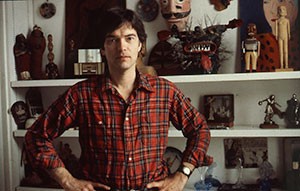Born 1941, Hamilton, Alabama
Died 1997, Atlanta, Georgia
A keen storyteller, Roger Brown modeled his paintings on the narrative paradigms of early Italian Renaissance painting, WPA murals, country music, comic books, and movies. His main subject was the American landscape and cityscape. Contrail Crucifix depicts a desert scene in a bold, simplified manner reminiscent of Georgia O’Keeffe and Grant Wood. Like a Sienese altarpiece or comic book page, the cross-shaped canvas is divided into discrete vignettes. The bottom section is unpopulated. The middle and top contain Brown’s signature cartoonish, silhouetted figures, each reaching toward jet contrails that form an ephemeral cross over the horizon.
The moral tone of Brown’s paintings is perhaps rooted in his religious upbringing in Opelika, Alabama. Brown studied to be a preacher in Nashville before moving to Chicago in 1962 to attend art school. He completed degrees in commercial design at the American Academy of Art, and in painting at the School of the Art Institute of Chicago, where his mentor, Ray Yoshida, nurtured his interest in vernacular art forms. Through Yoshida, Brown met local self-taught artists Joseph Yoakum and Aldo Piacenza. On road trips across the US, Brown visited folk artists Edgar Tolson in Kentucky and Jesse Howard in Fulton, Missouri, whose idiosyncratic treatment of biblical themes resonated with him: “whatever category one chooses—folk, naïve, outsider, or so-called regionalist… real artists exist and [are] nurtured outside the mainstream hierarchy. In fact I would venture to say that the only real artists are nurtured there . . . on the outside.”[1]
Brown extensively photographed visionary art environments—including S. P. Dinsmoor’s Garden of Eden in Lucas, Kansas; Grandma Prisbrey’s Bottle Village in Simi Valley, California; and Fred Smith’s Wisconsin Concrete Park, in Phillips, Wisconsin. And like these artists, he treated his Chicago home as an extension of his artwork. Carefully arranged objects gathered on the road and at flea markets covered every surface. His Virtual Still Life series of the mid-1990s, in which stylized landscape paintings serve as backdrops for ceramic vessels and other items arranged on shelves attached to the canvases, are the ultimate synthesis of his painting and collecting practices.
Antonia Pocock
[1] Roger Brown, “Setting the Stage,” in The Artworks of William Dawson (Chicago: Department of Public Affairs, for the Chicago Public Library Cultural Center, 1990), 10.
Kahan, Mitchell Douglas. Roger Brown. Montgomery, AL: Montgomery Museum of Fine Arts, 1980.
Lawrence, Sidney. Roger Brown: Southern Exposure. Auburn: Jule Collins Smith Museum of Fine Art at Auburn University, with the University of Alabama Press, Tuscaloosa, 2007.
